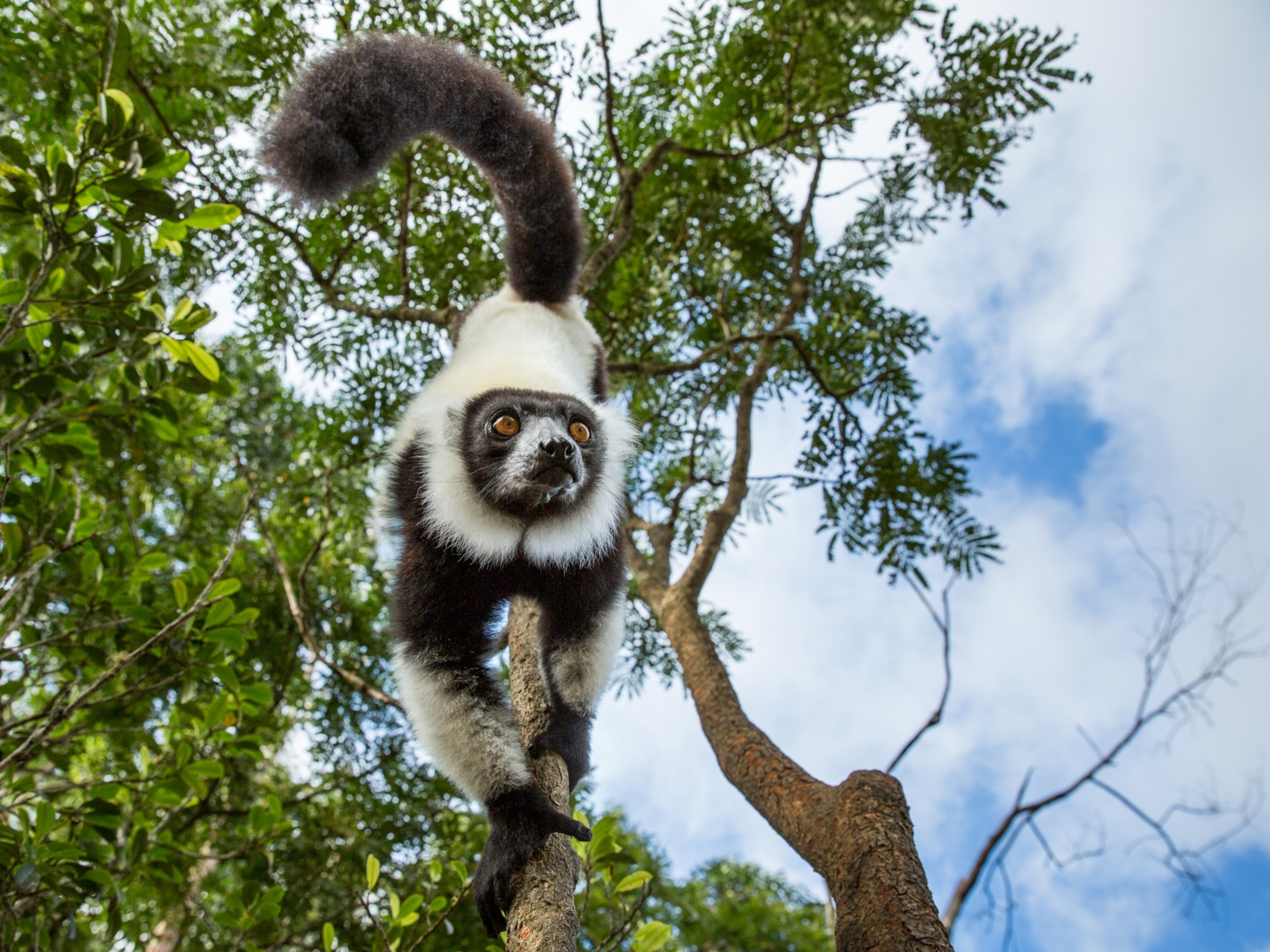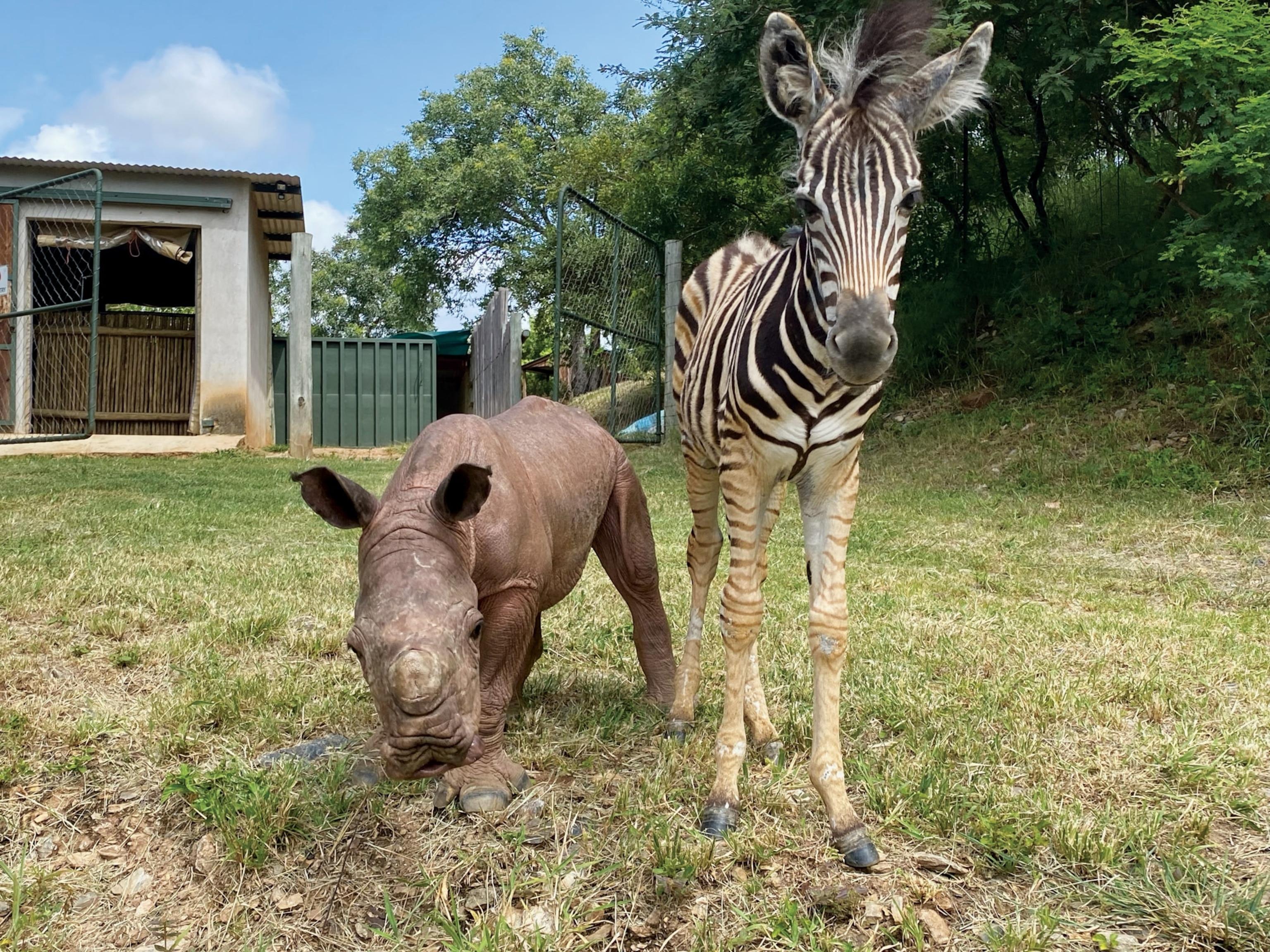
Hotels Offer a Wide-Eyed Amenity: Lemurs
Resorts in Madagascar offer up lemurs—some critically endangered—for selfies and entertainment.
Like hotels everywhere, those in the African nation of Madagascar tout their elegant rooms, lavish buffets, and sparkling swimming pools. But Madagascar’s resorts also lure guests with a furry amenity: lemurs.
New research indicates that a substantial number of tourist lodgings in Madagascar show off their pet lemurs. Some lemurs roam freely around the hotels and environs but depend on humans for their food. Other hotel lemurs live in cages or are tethered.
Many of these monkey-like animals are endangered, and keeping lemurs without a permit—which very few hotels have—violates Malagasy law.
One hotel has been the subject of multiple complaints to the government for leaving the animals in the sun and for tying them up so tightly that the leashes cut into their skin, says study author Kim Reuter, a conservation biologist in the Nairobi office of the nonprofit Conservation International.
Even if hotels take good care of these pets, they’re exposing them to human diseases. And although habitat destruction is a major cause of lemur loss in the wild, demand for the pet trade exacerbates the problem. As Reuter says, “If we don’t act on this in the next years, then I think we have some serious problems.”
If any animal is too cute for its own good, it’s the lemur. Many of the hundred-plus species of lemurs, which are distant relatives of apes and are all native to Madagascar, combine the most winning qualities of a koala, monkey, and kitten. With plush fur and winsome eyes, they’re the quarry of many visitors who come to Madagascar hoping to hug a lemur.
The Malgasy themselves aren’t immune to the animals’ charms. In research published last year Reuter and her colleagues calculated that roughly 28,000 lemurs have been kept as household pets in the past five years. Recently a few local kids tried to peddle a live mouse lemur to Justin Rickey, an American volunteering as a teacher. He says that when he declined, one of the boys said, “ ‘I’m going to keep it as a pet’ and took it home.”
Reuter wanted to know more about lemurs in the tourism industry and elsewhere, so she and colleague Melissa Schaefer, of the University of Utah, surveyed more than 170 hotel websites and social media sites. They found that 15 percent of the hotels featured shots of caged lemurs, people tete-a-tete with lemurs, or lemurs lounging on what look like hotel grounds, such as next to a swimming pool.
The TripAdvisor site for a hotel called La Petite Traversee, for example, contains numerous postings from guests marveling at the owner’s pet lemur. “Mikey the pet bamboo lemur provides additional entertainment,” wrote one guest. Photos depict other resident lemurs, and one post mentions a baby pet lemur that died. Hotel officials didn’t respond to emails seeking comment and could not be reached by phone.
Reuter and Schaefer found that the species most popular with private owners and hotels is the ring-tailed lemur, which is endangered. Also common as a pet is the crowned lemur, whose wild population is as low as 1,000.
Lisa Gould, a primate ecologist at the University of Victoria, in Canada, bemoans the situation. “I began to do research in Madagascar in the 1980s, and the pet trade wasn’t nearly as rampant as it is now. Things have deteriorated to an extremely bad situation.”
Hotel guests may not know that the bananas often fed to lemurs aren’t necessarily good for them, Reuter says. Nor will they realize that the appealing baby lemur being offered up for photo opps may very well have been captured in the wild after its mother was killed.
She urges tourists to keep a respectful distance from lemurs, no matter how much they want to cuddle them. And she and her colleagues are kicking off a campaign to educate the Malagasy public about the threat posed by the pet trade.
“It’s fairly easy, if you’re motivated, to go into the forest and take a lemur,” says Reuter, who receives funding from the National Geographic Society. But many owners don’t know how to care for their new pets, and “these endangered lemurs are then dying. I would consider that a real threat to the populations remaining in the field.”
Traci Watson writes about the microscopic beasties in our houses, huge galaxies millions of light years from Earth, and everything in between. She lives in Washington, D.C.
Read more stories about wildlife crime and exploitation on Wildlife Watch. Send tips, feedback, and story ideas to ngwildlife@natgeo.com.
Related Topics
You May Also Like
Go Further
Animals
- This fungus turns cicadas into zombies who procreate—then dieThis fungus turns cicadas into zombies who procreate—then die
- How can we protect grizzlies from their biggest threat—trains?How can we protect grizzlies from their biggest threat—trains?
- This ‘saber-toothed’ salmon wasn’t quite what we thoughtThis ‘saber-toothed’ salmon wasn’t quite what we thought
- Why this rhino-zebra friendship makes perfect senseWhy this rhino-zebra friendship makes perfect sense
Environment
- Your favorite foods may not taste the same in the future. Here's why.Your favorite foods may not taste the same in the future. Here's why.
- Are the Great Lakes the key to solving America’s emissions conundrum?Are the Great Lakes the key to solving America’s emissions conundrum?
- The world’s historic sites face climate change. Can Petra lead the way?The world’s historic sites face climate change. Can Petra lead the way?
- This pristine piece of the Amazon shows nature’s resilienceThis pristine piece of the Amazon shows nature’s resilience
- 30 years of climate change transformed into haunting music30 years of climate change transformed into haunting music
History & Culture
- When treasure hunters find artifacts, who gets to keep them?When treasure hunters find artifacts, who gets to keep them?
- Meet the original members of the tortured poets departmentMeet the original members of the tortured poets department
- When America's first ladies brought séances to the White HouseWhen America's first ladies brought séances to the White House
- Gambling is everywhere now. When is that a problem?Gambling is everywhere now. When is that a problem?
Science
- Should you be concerned about bird flu in your milk?Should you be concerned about bird flu in your milk?
- Here's how astronomers found one of the rarest phenomenons in spaceHere's how astronomers found one of the rarest phenomenons in space
- Not an extrovert or introvert? There’s a word for that.Not an extrovert or introvert? There’s a word for that.
Travel
- This striking city is home to some of Spain's most stylish hotelsThis striking city is home to some of Spain's most stylish hotels
- Photo story: a water-borne adventure into fragile AntarcticaPhoto story: a water-borne adventure into fragile Antarctica
- Germany's iconic castle has been renovated. Here's how to see itGermany's iconic castle has been renovated. Here's how to see it
- This tomb diver was among the first to swim beneath a pyramidThis tomb diver was among the first to swim beneath a pyramid




